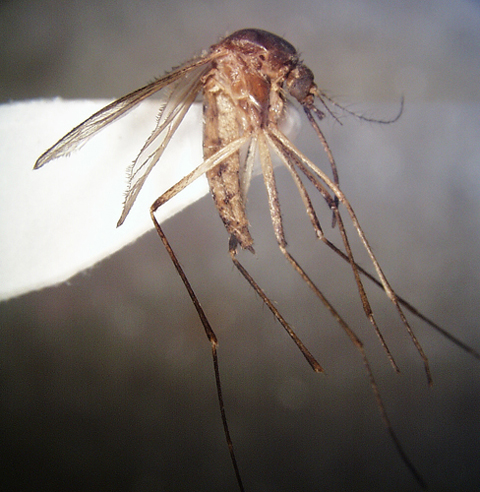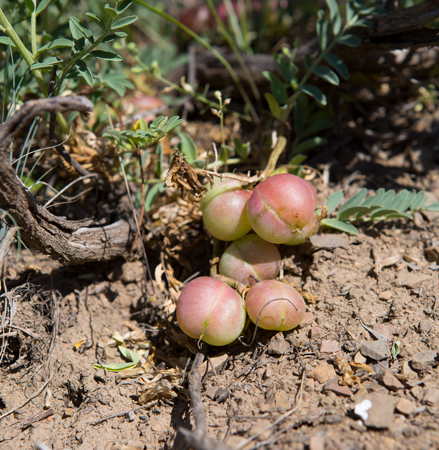At the mouth of the Osage, Clark is vexed by mosquitoes and deer ticks, and Lewis collects a specimen of ground plum (Astragalus crassicarpus). The captains record celestial observations before clouds obscure the sun. Late in the day, the boats move up to the mouth of the Moreau east of present-day Jefferson City. In St. Louis, Capt. Stoddard writes a letter to Secretary of War Henry Dearborn updating him on the expedition.
Mosquitoes, Ticks and a Cold
by Yellowstone Public Radio[1]Originally aired weekdays by Yellowstone Public Radio during the Bicentennial observance of 2003-2006. Narrated by Hal Hansen. Scripts by Whit Hansen and Ed Jacobson. Produced by Leni Holliman. © … Continue reading
Aedes vexans
Female
Courtesy John Haarstad, Cedar Creek Natural History Area, University of Minnesota
Aedes vexans (AY-eh-deez, Greek for “troublesome”; VEX-anz, “vexatious”) was, and still is, the most common species of mosquito in North America, and the main one that, as Lewis complained, “invaded and obstructed” them every year from late spring until early fall.
Astronomical Observations
Observed time and distance of
‘s and
‘s nearest limbs, the East:—
The
‘s disk was much obscured by clouds during this observation, not much confidence is therefore due it’s accuracy.—
—Meriwether Lewis
Clark’s Torments
I have a verry Sore Throat, & am Tormented with Musquetors & Small ticks.
—William Clark
Proceeding On
we lay at the osage R. the four part of the Day. the Hunters killed five Deer while we delayed at this place. we Set out at 5 oC. in the afternoon and proceeded along the Clifts. we encamped at Morow Creek on S. Side.
—John Ordway
Ground Plum
Astragalus crassicarpus
© 1 July 2015, Lewis and Clark Pass, by Kristopher K. Townsend. Permission to use granted under the Creative Commons Attribution-Share Alike 4.0 International license.
Lost Specimen No. 11
No. 11. Was taken the 3rd of June above the mouth of the Osage river; it is the groath of high dry open praries; rises to the hight of 18 inches or two feet puts forth many stems from the same root. The Indians frequently use the fruit of this plant to alay their thirst as they pass through these extensive dry praries common to many parts of the country bordering on the Missouri.—
—Meriwether Lewis
Moulton identifies this lost specimen, received by John Vaughn in 1805 (see The Donation Book), as Astragalus crassicarpa Nutt. var. berlandieri Barneb., ground plum.[2]Gary E. Moulton, ed. Journals, “Fort Mandan Miscellany”, vol 3:454, 467.
Captain Stoddard’s Update
From St. Louis, the commandant of Upper Louisiana, Amos Stoddard, updates the Secretary of War, Henry Dearborn, of the progress of the expedition.
St. Louis June 3d 1804.
I have the pleasure to inform you, that Captain Lewis, with his party, began to ascend the Missouri from the village of St. Charles on the 21 Ultimo. [He] began his expedition with a Barge of 18 oars, attended by two large perogues; all of which were deeply laden, and well manned.
. . . . .
A few weeks before he left this, he instructed an Indian trader by the name of Crawford with a parole and speech address to the Ayowas [Iowas] and Scioux [Yanktonai Sioux], who dwell on the banks of the river Demoine.
. . . . .
I presume that Capt. Lewis has mentioned to you the fate of some Osage Indians, who were on their way to this place in a boat belonging to Messrs. Mannuel & Benoit. The boat was fired on by the Saucks [Sauks and some of the Osage killed, and the others made prisoners.[3]Amos Stoddard to Henry Dearborn in Letters of the Lewis and Clark Expedition with Related Documents: 1783-1854, 2nd ed., ed. Donald Jackson (Urbana: University of Illinois Press, 1978), 196.
Experience the Lewis and Clark Trail
The Lewis and Clark Trail Experience—our sister site at lewisandclark.travel—connects the world to people and places on the Lewis and Clark Trail.
Plan a trip related to June 3, 1804:

Clark’s Hill State Historic Site is a High Potential Historic Site along the Lewis and Clark National Historic Trail managed by the U.S. National Park Service. Since Clark described this viewpoint, the Osage mouth has shifted six miles further downstream. The site, managed by Missouri State Parks, provides public access.
Notes
| ↑1 | Originally aired weekdays by Yellowstone Public Radio during the Bicentennial observance of 2003-2006. Narrated by Hal Hansen. Scripts by Whit Hansen and Ed Jacobson. Produced by Leni Holliman. © 2003 by Yellowstone Public Radio. |
|---|---|
| ↑2 | Gary E. Moulton, ed. Journals, “Fort Mandan Miscellany”, vol 3:454, 467. |
| ↑3 | Amos Stoddard to Henry Dearborn in Letters of the Lewis and Clark Expedition with Related Documents: 1783-1854, 2nd ed., ed. Donald Jackson (Urbana: University of Illinois Press, 1978), 196. |




